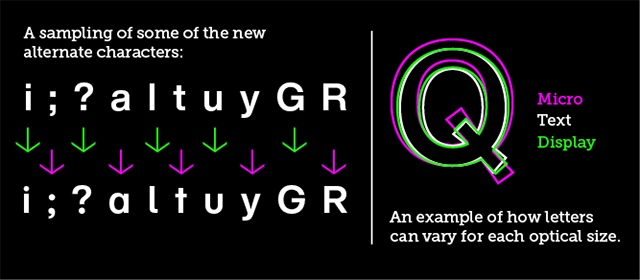We think so and here’s why Imbue is making that investment.

Monotype recently released a redesign of the popular typeface Helvetica®, called Helvetica Now. Type lover that I am, I admit to feeling a bit skeptical at first, which is why I had to take a deeper look. My conclusion is that Helvetica Now is indeed a much-improved version of the ubiquitous Helvetica typeface! This complete overhaul was designed with today’s needs in mind and works beautifully across a variety of digital and print applications.
A Brief History of Helvetica
Helvetica was created in 1957 in Switzerland by the Haas Type Foundry in order to compete with the popular sans serif typeface, Akzidenz-Grotesk. It was created by Max Miedinger and Eduard Hoffman and originally called Neue Haas Grotesk. They fulfilled the stated objective of designing a clear and neutral typeface and probably never imagined the ultimate success and longevity of their creation. The name was changed to Helvetica in 1960 to inspire wider international appeal. Helvetica means “Swiss” in Latin.
According to the author of The Visual History of Type by Paul McNeil, “It resonated with the post-war ideals of clarity, accuracy and objectivity that later became known as the Swiss or International Typographic Style.”1
In 1983, the Stempel Type Foundry in Germany came out with Helvetica Neue in order to meet the new requirements of digital typesetting. The original family was expanded to include a range of font styles from very light condensed weights to extra bold extended fonts. This redesign is still going strong but the entire family was based on one master for all sizes and as every good type nerd knows, that doesn’t translate into the best legibility across the spectrum.
Why Now, Exactly?
As communicators we are always looking for the best way to put the word out so to speak. Between the expanding world of digital and the ability to print finer fine print, were outdated fonts that were unable to keep up. These typefaces weren’t designed to seamlessly navigate between billboards, pixelated digital content, and fine print on product labels.
Charles Nix, one of the creators of Helvetica Now explained some of the reasons why he was excited about working on this redesign. He stressed the importance of optical sizing and explained that drawing different masters for each category actually harkened back to the days when metal punchcutters physically cut individual letters at each size in metal stamps. The various sizes were then tweaked by these artisans to look their best when printed.
Nix observed that people are using Helvetica in more expressive ways than the Swiss modern design aesthetic of the mid-1900s. Apparently many of the alternate characters existed before the 1983 arrival of Helvetica Neue but were left out of that version. Nix described the original version of Helvetica as more nuanced and wanted to bring some of that back into Now.
I’m not surprised to hear that Now is perhaps more sophisticated than Neue as we type aficionados in the 21st century are tending to look back and appreciate the craft of the originators of our favorite typefaces. Nix ended his talk by saying that he “hopes we see something in it that we haven’t seen before.” I’m excited to start looking!

The Nitty Gritty
This new set of “Now” contains 48 fonts in three optical size categories—Micro, Text, and Display. The characters in each size have been optimized for their particular use.
The Micro sizes (smaller than 8) were designed to be legible at very small sizes and online. The old Helvetica didn’t fare well in these arenas as the characters tended to fill in and run together. The new micro version has looser spacing and more open characters that help maintain their legibility.
The Text sizes, 8–12 point, were given more robust strokes and looser letter spacing in order to read well in passages of copy. It’s important to design type that reads easily because causing eye fatigue in your reader isn’t a great way to keep them looking at your content.
Display sizes are 14 point and above and were tailored for headlines. They are more tightly spaced to look their best at larger sizes. Designers typically have to hand-finesse the space between letters in logos and headlines to make them more cohesive.
Helvetica Now also includes eight sets of alternate characters that can be swapped in for a different look. For example, there’s a hooked version of the lowercase “L” to distinguish it from the capital “i”, a single-storey lowercase a, a straight-legged R, and a rounded “G”. A designer can “Now” (pun intended) choose between square punctuation dots or round.
Glossary: (From The Visual History of Type)1
Aperture—An area of negative space within a letter, partially enclosed by a stroke or strokes. See bowl.
Counter/Counterform—Any area of negative space within or between letters, completely or partially enclosed by a stroke or strokes.
Double-storeyed—A letter that has two counters, as in some forms of lowercase a and g.
Grotesk—The German name for a sans serif or A horizontal stroke that intersects the stem grotesque typeface.
Kerning—The horizontal spacing between two consecutive characters that compensates for letter combinations that would otherwise fit poorly.
- Paul McNeil, The Visual History of Type. (London: Laurence King Publishing Ltd., 2017), p. 347.


Comments